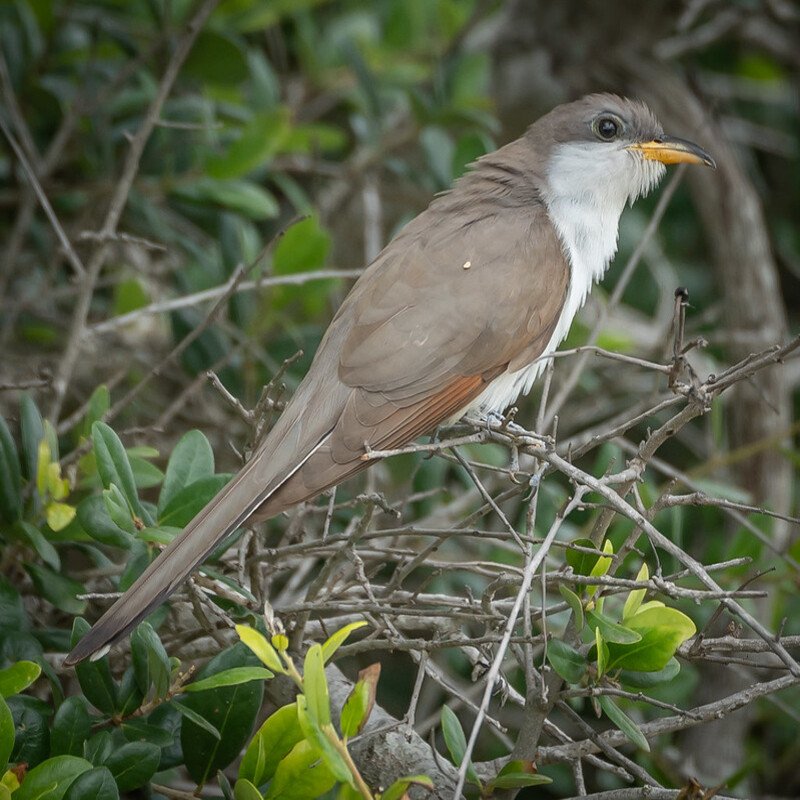Coccyzus americanus is commonly known as the yellow-billed cuckoo. Rain crow and storm crow are southern folk names for this bird. That the bird calls on hot days frequently means rain or thunderstorms. The genus name kokkuzo means “like a common cuckoo,” and Americana means “from America.”
Quick Overview: Coccyzus Americanus – Yellow-Billed Cuckoo
Body size: Around 11-13 in (28-33 cm) and a weight of 102 g (3.6 oz)
Main colors: Gray-Brown, White, Black, Yellow, Orange
Range: Throughout the United States
Migratory Bird: Yes
Best time of the year to see in the U.S.: June, July, August, September
Conservation Status: Least Concern
Yellow-Billed Cuckoo Description
Yellow-billed cuckoos have long tails and are medium-sized birds. Their head and back are grayish-brown, with dull white underparts. A pair of huge white rings line the underside of their lengthy tails. They have a small to medium curved bill with a black top mandible and a yellow or orange bottom mandible. These cuckoos have zygodactylous feet, meaning the center two toes point forward and the outer two backward.

Size
These birds have a length of 11-13 in (28-33 cm) and a weight of 102 g (3.6 oz). Their wings could range from 15-17 in (38-43 cm).
Feeding
Yellow-billed cuckoos consume caterpillars (order Lepidoptera), katydids, cicadas (family Cicadidae), grasshoppers, and crickets (order Orthoptera). Some fruits and seeds are eaten by them as well as bird eggs, snails, frogs (Order Anura) and lizards (Suborder Sauria). Chicks are fed regurgitated insects.
Habitat
This species prefers open woods with clearings and a thick shrub cover. They live near streams, rivers, and lakes. They like abandoned cropland, ancient fruit orchards, successional shrubland, and deep thickets in North America. Yellow-billed cuckoos spend the winter in similar environments like scrub forests and mangroves.
Behavior
Yellow-billed cuckoos are solitary or pair-breeding. They are territorial, but this is not well understood. Yellow-billed cuckoos migrate. They move in small or huge flocks at night. Yellow-billed cuckoos are diurnal except during migration.
Coccyzus americanus Scientific Classification
- Kingdom: Animalia
- Phylum: Chordata
- Subphylum: Chelicerata
- Class: Aves
- Order: Cuculiformes
- Family: Cuculidae
- Genus: Coccyzus
- Species: Coccyzus americanus
Other common names
Rain crow and storm crow are southern folk names for this bird.
Best time of the year to see
The best time to see these birds in the United States is during the summer season (June – September).
Distribution of the Yellow-Billed Cuckoo in the USA
Yellow-billed cuckoos are distributed in the Nearctic and Neotropics. They breed throughout eastern North America, particularly in Connecticut, Delaware, Massachusetts, Maryland, Maine, New Hampshire, southeast Canada, northern Mexico, and the Greater Antilles. They spend most of their time in South America throughout the winter.
The Yellow-Billed Cuckoo can be also found in the following states in the United States – Alabama, Alaska, Arizona, Arkansas, California, Colorado, Delaware, Florida, Georgia, Hawaii, Idaho, Illinois, Indiana, Iowa, Kansas, Kentucky, Louisiana, Michigan, Minnesota, Mississippi, Missouri, Montana, Nebraska, Nevada, New Jersey, New Mexico, New York, North Carolina, North Dakota, Ohio, Oklahoma, Oregon, Pennsylvania, Rhode Island, South Carolina, South Dakota, Tennessee, Texas, Utah, Vermont, Virginia, Washington, West Virginia, Wisconsin, and Wyoming.

